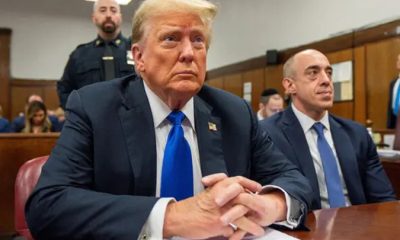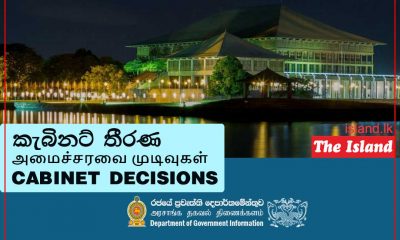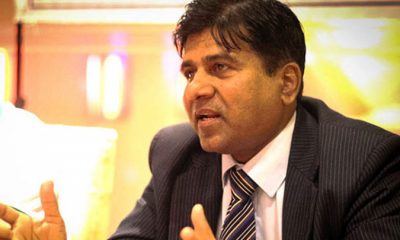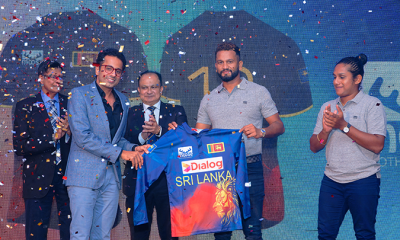Features
The Eastern Region and the 13th Amendment To The Sri Lankan Constitution

by K.Locana Gunaratna, PhD
Introduction
There is a claim made by some ethnic-based political groups in Sri Lanka about the areas of the Northern and Eastern regions of our country. Their claim is that the particular area are an integral part of a historic “Tamil Homeland”. Old Dutch maps are often used to substantiate their claim. Consequently, a demand has been strident among those particular political groups that these areas should be merged, have more political powers devolved to them by the Government and for this merged entity to have the right to maintain their own Police Force. During the late 1980s, an Indian military unit – the ‘Indian Peace-keeping Force’ (IPKF) – was deployed and active for a short while with intent to help the Sri Lankan government to curb the LTTE’s violence in the North and the East. At that very tense period, under strong pressure from the Indian government, a very rushed ‘accord’ was entered into between the two governments.
It required the so-called ‘temporary’ merger between the North and the East of Sri Lanka as one Province with devolved powers from the Central Government. This resulted in a hurriedly drafted 13th Amendment to the Sri Lankan Constitution being enacted in November 1987. It provided for substantial devolved powers from the Central Government not only to the North and the East but also to all other former provinces of Sri Lanka, nine in all. These provinces had been delineated during the British Colonial past for purely their administrative purposes. Thus, elected Provincial Councils became a reality along with a merged North and East. The latter merger was was subsequently disallowed by our Supreme Court. The promised referendum in the East to decide whether the people of that province wished to remain with the North was never held.
The policing rights have also not materialized. The N&E merger still continues to be demands among those particular ethnic-based political groups. It is important to recognize that by 1974, Provincial administration as a left-over from the colonial past had already been abandoned in favour of a more effective decentralization process. This process had already progressed to the devolution of political authority well beyond the former nine provincial boundaries to each of the 24 defined Districts. The government that came to power in 1977 consolidated the devolution process by establishing District Ministers, one for each of these Districts. Thus, decentralization and democratic devolution of centralized powers were by 1987 very well under way.
There clearly was no real necessity to revert back to the colonially derived Provinces and create new political potentates and administrations in the provinces in addition to the already existing 24 Districts Ministries. This overlap of functions has resulted in substantial and unnecessary annually recurrent costs. This is the confused and wasteful context we are in right now and needs to be put right without delay.
The Eastern Region
As most Sri Lankans are aware, there were three distinct European colonial periods in our history: chronologically, the Portuguese, the Dutch and finally the British period. The Portuguese and the Dutch had initially gained control only over some of our coastal territories. They had no control over our central hill-country which in those years was firmly under the King of Kandy. What is most relevant to the specific discussion here on the Eastern region is the Dutch period. Dutch rule in Sri Lanka was not directly by their government but by the United Dutch East India Company (Vereenigde Nederlandsche Oost Indische Compagnie) popularly known as the ‘VOC’. It was the resulting when, in the 17th Century, the Dutch government had successfully directed the of several rival Dutch trading companies.
Some important historical facts of the period relating to the Dutch occupation of Sri Lanka are to be found in the writings of a Dutch Priest Rev. Phillipus Baldeus. He was himself present here in the island during the time of his writings which were later published in 1672. These publications were translated in relatively recent times from the original Dutch into English by Pieter Brohier, a Sri Lankan scholar of Dutch origin. That English version entitled “A TRUE AND EXACT DESCRIPTION OF THE GREAT ISLAND OF CEYLON” was itself first published here in the “Ceylon Historical Journal” (Volume VIII July 1958-April 1959 nos. 1-4). It was also published later as a book printed in September 1960 (Saman Press, Maharagama, Sri Lanka).
According to Rev. Baldeus, during the late period of Portuguese occupation, the VOC had wanted to get in touch with the King of Kandy. They thus sent Admiral Joris Van Spilbergen with two ships to Sri Lanka. He and his men arrived on May 31, 1602 on the East Coast in Batticaloa. They went to that location because it was not occupied by the Portuguese and was known to be an integral part of the Kingdom of Kandy. He and some of his men then proceeded from Batticaloa to Kandy by foot with absolutely no hindrance from any, including the Portuguese.
His mission (p33) was to convey greetings from Prince Mauritius de Nassau of the Netherlands to the King of Kandy, establish cordial relations and also to conspire against the Portuguese who were then in control of Sri Lanka’s Western and Northern seaboards. Seven years later, on October 5, 1609, Prince Mauritius de Nassau addressed a letter to the King of Kandy. The letter was delivered by one Marcellus Boschhouwer (p 47) who also arrived on the East Coast of Sri Lanka and proceeded to Kandy.
Two decades later in 1622, according to Rev. Baldeus, the Portuguese having by then come to the East, destroyed a “pagoda” in what is now Trincomalee, used the salvaged stone to build a military fort there (pp 84, 85). Five years later, the Portuguese took 13 companies of their soldiers to Batticaloa and erected another fortification there (p 87). Rev. Baldeus states that in both instances the King of Kandy sent troops to prevent this construction work from taking place within his territory, but those troops were repulsed by the Portuguese.
Rev. Baldeus continues to say that Adam Westerwold, Commander in Chief of the Dutch Fleet based in India, having routed the Portuguese in Goa, arrived on the east coast of Sri Lanka in 1638. They together with an army from Kandy captured the fortress in Batticaloa from the Portuguese. King Rajasingha of Kandy himself had made his appearance there as it was within his territory. The Dutch Admiral acting on behalf of the Prince of Orange then entered into a contract with the King of Kandy. Brohier’s translation (in footnote 1 on page 123) states that the Dutch also captured the Portuguese fort at Trincomalee on May 2, 1639 and that it was handed over to King Rajasingha of Kandy in the following year. That fort was thereafter dismantled. However, Batticaloa was not returned to the King of Kandy.
Rev. Baldeus goes on to convey that subsequently, Galle, Kalutara and eventually Colombo, all being in the Island’s Southwest coast, were also taken by the Dutch from the Portuguese with some military support from the King of Kandy. However, the relations between them became very strained. That was because the strategic coastal areas taken from the Portuguese including Batticaloa and Colombo were all not returned to the King of Kandy. The king therefore refused to reimburse the Dutch any of their expenses. Thus, much of the island excluding the Kandyan hill country but also including the Eastern region came under Dutch control as shown in maps drawn thereafter by the Dutch. Later, the same areas came under British control when the Dutch capitulated to the British.
Conclusions
There are no reasons to doubt the veracity of the learned Dutch Priest Rev. Baldeus and his “True and Exact Description…” of what took place between the VOC, the King of Kandy, the Portuguese, and also the VOC’s activities in the Eastern region of Sri Lanka. It is thus clear that Sri Lanka’s Eastern region at the time of the Portuguese presence was an integral part of the Kingdom of Kandy. It provided for the Kingdom’s legitimate and ready access to the ocean at that time. That access was denied by the Dutch and later by the British, making the Kandyan Kingdom land-locked. The respective colonial maps were drawn accordingly.
It also becomes quite clear that the Eastern Region of Sri Lanka was not part of the currently claimed historical “Traditional Tamil Homeland”, neither in the 17thCentury nor before. There may well have been some Tamil villages existing harmoniously in the East among the majority Sinhalese under rule from Kandy. These Tamil families could well have been of a different caste than the dominant castes in the North.
There are several prominent ancient Buddhist sites of religious and archaeological merit in several districts of the East. Their original monuments would have taken a great many decades to construct. Thus, they clearly evidence the predominant earlier prolonged presence of Sinhalese settlements in the Eastern region. Even just before the outbreak of the 30-year war with the LTTE, the Eastern region was home not only to Tamils but also to many Muslims and Sinhalese who together outnumbered the Tamils.. It was one of the geographic contexts in which the LTTE’s many well-recorded brutal efforts at ‘Ethnic Cleansing’ were committed through mass massacres of Muslims and Sinhalese. Just two examples of such massacres were those committed respectively at Kattankudi and at Aranthalaawa.
(The writer is Fellow and Past President, National Academy of Sciences Sri Lanka, Past General President, Sri Lanka Association for the Advancement of Science Fellow and Past President, Institute of Town Planners Sri Lanka, Fellow and Past President, Sri Lanka Institute of Architects, Vice President Sri Lanka Economic Association.)
Features
The heart-friendly health minister

by Dr Gotabhya Ranasinghe
Senior Consultant Cardiologist
National Hospital Sri Lanka
When we sought a meeting with Hon Dr. Ramesh Pathirana, Minister of Health, he graciously cleared his busy schedule to accommodate us. Renowned for his attentive listening and deep understanding, Minister Pathirana is dedicated to advancing the health sector. His openness and transparency exemplify the qualities of an exemplary politician and minister.
Dr. Palitha Mahipala, the current Health Secretary, demonstrates both commendable enthusiasm and unwavering support. This combination of attributes makes him a highly compatible colleague for the esteemed Minister of Health.
Our discussion centered on a project that has been in the works for the past 30 years, one that no other minister had managed to advance.
Minister Pathirana, however, recognized the project’s significance and its potential to revolutionize care for heart patients.
The project involves the construction of a state-of-the-art facility at the premises of the National Hospital Colombo. The project’s location within the premises of the National Hospital underscores its importance and relevance to the healthcare infrastructure of the nation.
This facility will include a cardiology building and a tertiary care center, equipped with the latest technology to handle and treat all types of heart-related conditions and surgeries.
Securing funding was a major milestone for this initiative. Minister Pathirana successfully obtained approval for a $40 billion loan from the Asian Development Bank. With the funding in place, the foundation stone is scheduled to be laid in September this year, and construction will begin in January 2025.
This project guarantees a consistent and uninterrupted supply of stents and related medications for heart patients. As a result, patients will have timely access to essential medical supplies during their treatment and recovery. By securing these critical resources, the project aims to enhance patient outcomes, minimize treatment delays, and maintain the highest standards of cardiac care.
Upon its fruition, this monumental building will serve as a beacon of hope and healing, symbolizing the unwavering dedication to improving patient outcomes and fostering a healthier society.We anticipate a future marked by significant progress and positive outcomes in Sri Lanka’s cardiovascular treatment landscape within the foreseeable timeframe.
Features
A LOVING TRIBUTE TO JESUIT FR. ALOYSIUS PIERIS ON HIS 90th BIRTHDAY

by Fr. Emmanuel Fernando, OMI
Jesuit Fr. Aloysius Pieris (affectionately called Fr. Aloy) celebrated his 90th birthday on April 9, 2024 and I, as the editor of our Oblate Journal, THE MISSIONARY OBLATE had gone to press by that time. Immediately I decided to publish an article, appreciating the untiring selfless services he continues to offer for inter-Faith dialogue, the renewal of the Catholic Church, his concern for the poor and the suffering Sri Lankan masses and to me, the present writer.
It was in 1988, when I was appointed Director of the Oblate Scholastics at Ampitiya by the then Oblate Provincial Fr. Anselm Silva, that I came to know Fr. Aloy more closely. Knowing well his expertise in matters spiritual, theological, Indological and pastoral, and with the collaborative spirit of my companion-formators, our Oblate Scholastics were sent to Tulana, the Research and Encounter Centre, Kelaniya, of which he is the Founder-Director, for ‘exposure-programmes’ on matters spiritual, biblical, theological and pastoral. Some of these dimensions according to my view and that of my companion-formators, were not available at the National Seminary, Ampitiya.
Ever since that time, our Oblate formators/ accompaniers at the Oblate Scholasticate, Ampitiya , have continued to send our Oblate Scholastics to Tulana Centre for deepening their insights and convictions regarding matters needed to serve the people in today’s context. Fr. Aloy also had tried very enthusiastically with the Oblate team headed by Frs. Oswald Firth and Clement Waidyasekara to begin a Theologate, directed by the Religious Congregations in Sri Lanka, for the contextual formation/ accompaniment of their members. It should very well be a desired goal of the Leaders / Provincials of the Religious Congregations.
Besides being a formator/accompanier at the Oblate Scholasticate, I was entrusted also with the task of editing and publishing our Oblate journal, ‘The Missionary Oblate’. To maintain the quality of the journal I continue to depend on Fr. Aloy for his thought-provoking and stimulating articles on Biblical Spirituality, Biblical Theology and Ecclesiology. I am very grateful to him for his generous assistance. Of late, his writings on renewal of the Church, initiated by Pope St. John XX111 and continued by Pope Francis through the Synodal path, published in our Oblate journal, enable our readers to focus their attention also on the needed renewal in the Catholic Church in Sri Lanka. Fr. Aloy appreciated very much the Synodal path adopted by the Jesuit Pope Francis for the renewal of the Church, rooted very much on prayerful discernment. In my Religious and presbyteral life, Fr.Aloy continues to be my spiritual animator / guide and ongoing formator / acccompanier.
Fr. Aloysius Pieris, BA Hons (Lond), LPh (SHC, India), STL (PFT, Naples), PhD (SLU/VC), ThD (Tilburg), D.Ltt (KU), has been one of the eminent Asian theologians well recognized internationally and one who has lectured and held visiting chairs in many universities both in the West and in the East. Many members of Religious Congregations from Asian countries have benefited from his lectures and guidance in the East Asian Pastoral Institute (EAPI) in Manila, Philippines. He had been a Theologian consulted by the Federation of Asian Bishops’ Conferences for many years. During his professorship at the Gregorian University in Rome, he was called to be a member of a special group of advisers on other religions consulted by Pope Paul VI.
Fr. Aloy is the author of more than 30 books and well over 500 Research Papers. Some of his books and articles have been translated and published in several countries. Among those books, one can find the following: 1) The Genesis of an Asian Theology of Liberation (An Autobiographical Excursus on the Art of Theologising in Asia, 2) An Asian Theology of Liberation, 3) Providential Timeliness of Vatican 11 (a long-overdue halt to a scandalous millennium, 4) Give Vatican 11 a chance, 5) Leadership in the Church, 6) Relishing our faith in working for justice (Themes for study and discussion), 7) A Message meant mainly, not exclusively for Jesuits (Background information necessary for helping Francis renew the Church), 8) Lent in Lanka (Reflections and Resolutions, 9) Love meets wisdom (A Christian Experience of Buddhism, 10) Fire and Water 11) God’s Reign for God’s poor, 12) Our Unhiddden Agenda (How we Jesuits work, pray and form our men). He is also the Editor of two journals, Vagdevi, Journal of Religious Reflection and Dialogue, New Series.
Fr. Aloy has a BA in Pali and Sanskrit from the University of London and a Ph.D in Buddhist Philosophy from the University of Sri Lankan, Vidyodaya Campus. On Nov. 23, 2019, he was awarded the prestigious honorary Doctorate of Literature (D.Litt) by the Chancellor of the University of Kelaniya, the Most Venerable Welamitiyawe Dharmakirthi Sri Kusala Dhamma Thera.
Fr. Aloy continues to be a promoter of Gospel values and virtues. Justice as a constitutive dimension of love and social concern for the downtrodden masses are very much noted in his life and work. He had very much appreciated the commitment of the late Fr. Joseph (Joe) Fernando, the National Director of the Social and Economic Centre (SEDEC) for the poor.
In Sri Lanka, a few religious Congregations – the Good Shepherd Sisters, the Christian Brothers, the Marist Brothers and the Oblates – have invited him to animate their members especially during their Provincial Congresses, Chapters and International Conferences. The mainline Christian Churches also have sought his advice and followed his seminars. I, for one, regret very much, that the Sri Lankan authorities of the Catholic Church –today’s Hierarchy—- have not sought Fr.
Aloy’s expertise for the renewal of the Catholic Church in Sri Lanka and thus have not benefited from the immense store of wisdom and insight that he can offer to our local Church while the Sri Lankan bishops who governed the Catholic church in the immediate aftermath of the Second Vatican Council (Edmund Fernando OMI, Anthony de Saram, Leo Nanayakkara OSB, Frank Marcus Fernando, Paul Perera,) visited him and consulted him on many matters. Among the Tamil Bishops, Bishop Rayappu Joseph was keeping close contact with him and Bishop J. Deogupillai hosted him and his team visiting him after the horrible Black July massacre of Tamils.
Features
A fairy tale, success or debacle

Sri Lanka-Singapore Free Trade Agreement
By Gomi Senadhira
senadhiragomi@gmail.com
“You might tell fairy tales, but the progress of a country cannot be achieved through such narratives. A country cannot be developed by making false promises. The country moved backward because of the electoral promises made by political parties throughout time. We have witnessed that the ultimate result of this is the country becoming bankrupt. Unfortunately, many segments of the population have not come to realize this yet.” – President Ranil Wickremesinghe, 2024 Budget speech
Any Sri Lankan would agree with the above words of President Wickremesinghe on the false promises our politicians and officials make and the fairy tales they narrate which bankrupted this country. So, to understand this, let’s look at one such fairy tale with lots of false promises; Ranil Wickremesinghe’s greatest achievement in the area of international trade and investment promotion during the Yahapalana period, Sri Lanka-Singapore Free Trade Agreement (SLSFTA).
It is appropriate and timely to do it now as Finance Minister Wickremesinghe has just presented to parliament a bill on the National Policy on Economic Transformation which includes the establishment of an Office for International Trade and the Sri Lanka Institute of Economics and International Trade.
Was SLSFTA a “Cleverly negotiated Free Trade Agreement” as stated by the (former) Minister of Development Strategies and International Trade Malik Samarawickrama during the Parliamentary Debate on the SLSFTA in July 2018, or a colossal blunder covered up with lies, false promises, and fairy tales? After SLSFTA was signed there were a number of fairy tales published on this agreement by the Ministry of Development Strategies and International, Institute of Policy Studies, and others.
However, for this article, I would like to limit my comments to the speech by Minister Samarawickrama during the Parliamentary Debate, and the two most important areas in the agreement which were covered up with lies, fairy tales, and false promises, namely: revenue loss for Sri Lanka and Investment from Singapore. On the other important area, “Waste products dumping” I do not want to comment here as I have written extensively on the issue.
1. The revenue loss
During the Parliamentary Debate in July 2018, Minister Samarawickrama stated “…. let me reiterate that this FTA with Singapore has been very cleverly negotiated by us…. The liberalisation programme under this FTA has been carefully designed to have the least impact on domestic industry and revenue collection. We have included all revenue sensitive items in the negative list of items which will not be subject to removal of tariff. Therefore, 97.8% revenue from Customs duty is protected. Our tariff liberalisation will take place over a period of 12-15 years! In fact, the revenue earned through tariffs on goods imported from Singapore last year was Rs. 35 billion.
The revenue loss for over the next 15 years due to the FTA is only Rs. 733 million– which when annualised, on average, is just Rs. 51 million. That is just 0.14% per year! So anyone who claims the Singapore FTA causes revenue loss to the Government cannot do basic arithmetic! Mr. Speaker, in conclusion, I call on my fellow members of this House – don’t mislead the public with baseless criticism that is not grounded in facts. Don’t look at petty politics and use these issues for your own political survival.”
I was surprised to read the minister’s speech because an article published in January 2018 in “The Straits Times“, based on information released by the Singaporean Negotiators stated, “…. With the FTA, tariff savings for Singapore exports are estimated to hit $10 million annually“.
As the annual tariff savings (that is the revenue loss for Sri Lanka) calculated by the Singaporean Negotiators, Singaporean $ 10 million (Sri Lankan rupees 1,200 million in 2018) was way above the rupees’ 733 million revenue loss for 15 years estimated by the Sri Lankan negotiators, it was clear to any observer that one of the parties to the agreement had not done the basic arithmetic!
Six years later, according to a report published by “The Morning” newspaper, speaking at the Committee on Public Finance (COPF) on 7th May 2024, Mr Samarawickrama’s chief trade negotiator K.J. Weerasinghehad had admitted “…. that forecasted revenue loss for the Government of Sri Lanka through the Singapore FTA is Rs. 450 million in 2023 and Rs. 1.3 billion in 2024.”
If these numbers are correct, as tariff liberalisation under the SLSFTA has just started, we will pass Rs 2 billion very soon. Then, the question is how Sri Lanka’s trade negotiators made such a colossal blunder. Didn’t they do their basic arithmetic? If they didn’t know how to do basic arithmetic they should have at least done their basic readings. For example, the headline of the article published in The Straits Times in January 2018 was “Singapore, Sri Lanka sign FTA, annual savings of $10m expected”.
Anyway, as Sri Lanka’s chief negotiator reiterated at the COPF meeting that “…. since 99% of the tariffs in Singapore have zero rates of duty, Sri Lanka has agreed on 80% tariff liberalisation over a period of 15 years while expecting Singapore investments to address the imbalance in trade,” let’s turn towards investment.
Investment from Singapore
In July 2018, speaking during the Parliamentary Debate on the FTA this is what Minister Malik Samarawickrama stated on investment from Singapore, “Already, thanks to this FTA, in just the past two-and-a-half months since the agreement came into effect we have received a proposal from Singapore for investment amounting to $ 14.8 billion in an oil refinery for export of petroleum products. In addition, we have proposals for a steel manufacturing plant for exports ($ 1 billion investment), flour milling plant ($ 50 million), sugar refinery ($ 200 million). This adds up to more than $ 16.05 billion in the pipeline on these projects alone.
And all of these projects will create thousands of more jobs for our people. In principle approval has already been granted by the BOI and the investors are awaiting the release of land the environmental approvals to commence the project.
I request the Opposition and those with vested interests to change their narrow-minded thinking and join us to develop our country. We must always look at what is best for the whole community, not just the few who may oppose. We owe it to our people to courageously take decisions that will change their lives for the better.”
According to the media report I quoted earlier, speaking at the Committee on Public Finance (COPF) Chief Negotiator Weerasinghe has admitted that Sri Lanka was not happy with overall Singapore investments that have come in the past few years in return for the trade liberalisation under the Singapore-Sri Lanka Free Trade Agreement. He has added that between 2021 and 2023 the total investment from Singapore had been around $162 million!
What happened to those projects worth $16 billion negotiated, thanks to the SLSFTA, in just the two-and-a-half months after the agreement came into effect and approved by the BOI? I do not know about the steel manufacturing plant for exports ($ 1 billion investment), flour milling plant ($ 50 million) and sugar refinery ($ 200 million).
However, story of the multibillion-dollar investment in the Petroleum Refinery unfolded in a manner that would qualify it as the best fairy tale with false promises presented by our politicians and the officials, prior to 2019 elections.
Though many Sri Lankans got to know, through the media which repeatedly highlighted a plethora of issues surrounding the project and the questionable credentials of the Singaporean investor, the construction work on the Mirrijiwela Oil Refinery along with the cement factory began on the24th of March 2019 with a bang and Minister Ranil Wickremesinghe and his ministers along with the foreign and local dignitaries laid the foundation stones.
That was few months before the 2019 Presidential elections. Inaugurating the construction work Prime Minister Ranil Wickremesinghe said the projects will create thousands of job opportunities in the area and surrounding districts.
The oil refinery, which was to be built over 200 acres of land, with the capacity to refine 200,000 barrels of crude oil per day, was to generate US$7 billion of exports and create 1,500 direct and 3,000 indirect jobs. The construction of the refinery was to be completed in 44 months. Four years later, in August 2023 the Cabinet of Ministers approved the proposal presented by President Ranil Wickremesinghe to cancel the agreement with the investors of the refinery as the project has not been implemented! Can they explain to the country how much money was wasted to produce that fairy tale?
It is obvious that the President, ministers, and officials had made huge blunders and had deliberately misled the public and the parliament on the revenue loss and potential investment from SLSFTA with fairy tales and false promises.
As the president himself said, a country cannot be developed by making false promises or with fairy tales and these false promises and fairy tales had bankrupted the country. “Unfortunately, many segments of the population have not come to realize this yet”.
(The writer, a specialist and an activist on trade and development issues . )
























